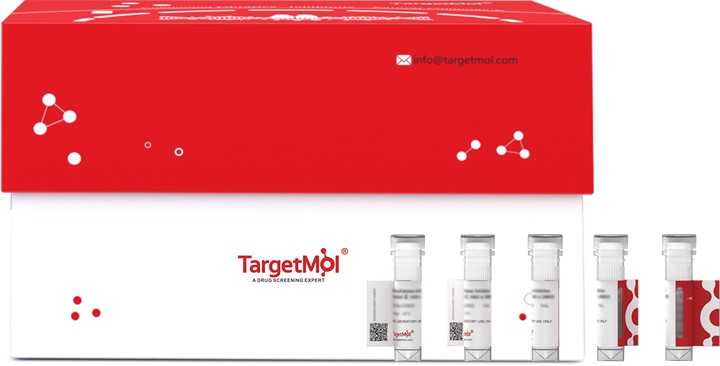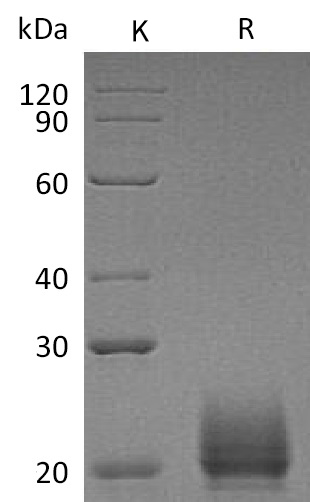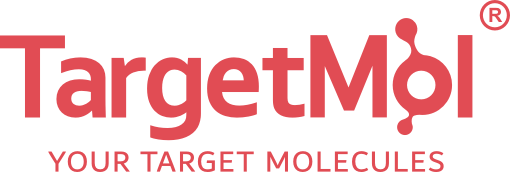- 全部删除
 您的购物车当前为空
您的购物车当前为空
CXCL9 Protein, Mouse, Recombinant (His)
Chemokine (C-X-C motif) ligand 9 (CXCL9, MIG), is a small cytokine belonging to the CXC chemokine family. CXCL9 functions as one of the three ligands of chemokine receptor CXCR3 which is a G protein-coupled receptor found predominantly on T cells. It together with CXCL10 and CXCL11, may activate CXCR3 by binding to it. CXCL9 serves as a cytokine that affects the growth, movement, or activation state of cells that participate in immune and inflammatory response. It has been observed that tumour endothelial cells secrete high levels of CXCL9 in all, and CXCL10 in most melanoma metastases. it plays an important role in CD4+ T lymphocyte recruitment and development of CAV, MOMA-2+ macrophages are the predominant recipient-derived source of CXCL9, and recipient CD4 lymphocytes are necessary for sustained CXCL9 production and CAV development in this model.

CXCL9 Protein, Mouse, Recombinant (His)
| 规格 | 价格 | 库存 | 数量 |
|---|---|---|---|
| 10 μg | ¥ 910 | 5日内发货 | |
| 50 μg | ¥ 2,760 | 5日内发货 | |
| 500 μg | ¥ 9,730 | 5日内发货 | |
| 1 mg | ¥ 13,900 | 5日内发货 |
产品信息
| 生物活性 | Activity has not been tested. It is theoretically active, but we cannot guarantee it. If you require protein activity, we recommend choosing the eukaryotic expression version first. |
| 产品描述 | Chemokine (C-X-C motif) ligand 9 (CXCL9, MIG), is a small cytokine belonging to the CXC chemokine family. CXCL9 functions as one of the three ligands of chemokine receptor CXCR3 which is a G protein-coupled receptor found predominantly on T cells. It together with CXCL10 and CXCL11, may activate CXCR3 by binding to it. CXCL9 serves as a cytokine that affects the growth, movement, or activation state of cells that participate in immune and inflammatory response. It has been observed that tumour endothelial cells secrete high levels of CXCL9 in all, and CXCL10 in most melanoma metastases. it plays an important role in CD4+ T lymphocyte recruitment and development of CAV, MOMA-2+ macrophages are the predominant recipient-derived source of CXCL9, and recipient CD4 lymphocytes are necessary for sustained CXCL9 production and CAV development in this model. |
| 种属 | Mouse |
| 表达系统 | HEK293 Cells |
| 标签 | C-6xHis |
| 蛋白编号 | P18340 |
| 别名 | γ-interferon-induced monokine,Small-inducible cytokine B9,Scyb9,Protein m119,MuMIG,Monokine induced by interferon-γ,Monokine induced by interferon-gamma,Mig,Gamma-interferon-induced monokine,Cxcl9,C-X-C motif chemokine 9 |
| 氨基酸序列 | Thr22-Thr126 |
| 蛋白构建 | Thr22-Thr126 |
| 蛋白纯度 | Greater than 95% as determined by reducing SDS-PAGE. (QC verified)  |
| 分子量 | 18-25 KDa (reducing condition) |
| 内毒素 | < 0.1 ng/µg (1 EU/µg) as determined by LAL test. |
| 缓冲液 | Lyophilized from a solution filtered through a 0.22 μm filter, containing PBS, pH 7.4. |
| 复溶方法 | Reconstitute the lyophilized protein in distilled water. The product concentration should not be less than 100 μg/ml. Before opening, centrifuge the tube to collect powder at the bottom. After adding the reconstitution buffer, avoid vortexing or pipetting for mixing. |
| 存储 | Lyophilized powders can be stably stored for over 12 months, while liquid products can be stored for 6-12 months at -80°C. For reconstituted protein solutions, the solution can be stored at -20°C to -80°C for at least 3 months. Please avoid multiple freeze-thaw cycles and store products in aliquots. |
| 运输方式 | In general, Lyophilized powders are shipping with blue ice. Solutions are shipping with dry ice. |
| 研究背景 | Chemokine (C-X-C motif) ligand 9 (CXCL9, MIG), is a small cytokine belonging to the CXC chemokine family. CXCL9 functions as one of the three ligands of chemokine receptor CXCR3 which is a G protein-coupled receptor found predominantly on T cells. It together with CXCL10 and CXCL11, may activate CXCR3 by binding to it. CXCL9 serves as a cytokine that affects the growth, movement, or activation state of cells that participate in immune and inflammatory response. It has been observed that tumour endothelial cells secrete high levels of CXCL9 in all, and CXCL10 in most melanoma metastases. it plays an important role in CD4+ T lymphocyte recruitment and development of CAV, MOMA-2+ macrophages are the predominant recipient-derived source of CXCL9, and recipient CD4 lymphocytes are necessary for sustained CXCL9 production and CAV development in this model. |




